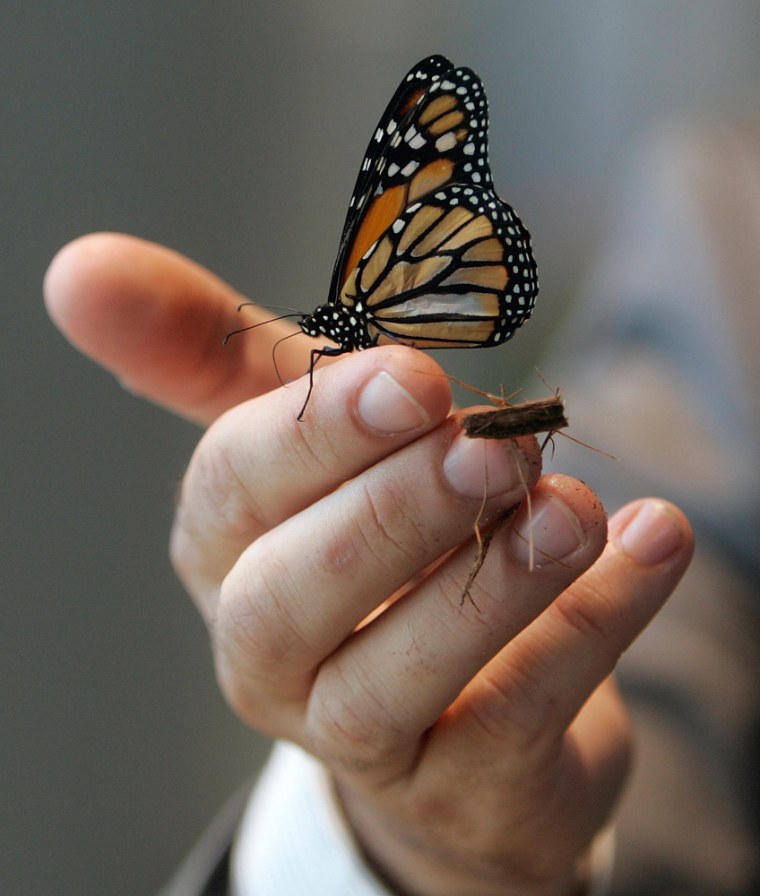Ron Forman wants to change grown-ups' views of bugs and spiders from "ewww!" to "cool!" After all, such critters clean the earth, pollinate plants and form a huge chunk of the food chain.
"Without insects, nature doesn't exist," said Forman, chief executive of the new Audubon Insectarium, the first major tourist attraction to open in New Orleans since Hurricane Katrina.
The facility, built with $6.2 million in private donations and $20 million in public money, is one of only a few stand-alone, nonprofit insectariums.
In New Orleans, displays include spiders, centipedes and crawfish as well as ants, mosquitoes and other insectoid six-leggers. Nit-pickers might say that means it isn't an insectarium. "Arthropodarium" might be appropriate.
Whatever it's called, thousands of live and mounted bugs went on display when the Insectarium opened June 13 in 23,000 square feet of the old U.S. Custom House near the French Quarter.
Some creatures, like the butterflies stretching crumpled wings in the metamorphosis room and fluttering about the Japanese-style butterfly garden, are short-lived. The butterfly population is kept up by purchasing about 700 a week in chrysalis form, the stage between caterpillar and adult.
35,000 live residents estimated
Chief entomologist Jayme Necaise estimates 35,000 live residents, with another 15,000 mounted, emphasizing there's no way to get a headcount on the colonies of ants and termites.
Hurricane Katrina dealt a setback to plans for opening the insectarium when it flooded 80 percent of New Orleans in August 2005. Audubon Institute's Aquarium of the Americas on the riverfront took heavy damage, though the Audubon Zoo fared better.
The insectarium had been expected to open in the summer of 2007. The Custom House stayed dry, but it was a year before the federal government let workers back into the building.
The Custom House's historic status — construction started in 1849 — challenged builders and designers. Nothing could be permanently installed, Audubon spokeswoman Melissa Lee said. Backdrops are painted and sculpted on tall wooden walls within the high-ceilinged rooms and corridors. The institute needed federal permission to disguise a fat load-bearing column in one room as a cypress tree.
The tall, wide doors are untouched, so people can see where horse-drawn carriages once hauled imports and exports for inspection by customs agents, Lee said.
The rest is a mix of science and whimsy. A wide entry room where visitors can wait and buy tickets opens into the carriageway and an exhibit about prehistoric bugs.
Models of dragonflies with 30-inch wingspans move on tracks below the ceiling. "They really were that big," Lee said. In a case, a less-than-life-size model Coelophysis — a sharp-toothed raptor that grew up to 9 feet high — chases a fist-sized model dragonfly.
Off the carriageway is a tunnel designed to give people a bug's-eye-view from underground. An earthworm about 18 inches across loops through one bit; mites are the size of plums.
'They're so cute!'
Outside bathrooms, dung beetles roll balls of waste in an exhibit framed by a yard-high imitation of such a ball. Entomologist Zachary Lemann leaned over in wonder at the bugs. "Look at them. They're so cute! So cuuuuute!"
Lemann doesn't just coo over bugs; he cooks them, working with Insectarium chef Alan Ehrich in the display kitchen where photographs include a huge picture of a Thai child happily eating spiders-on-a-stick.
Visitors are offered free samples of edible bug snacks like "chocolate chirp cookies," crispy Cajun crickets, mealworm egg rolls and deep-fried dragonflies.
Some exhibits are themed, including Termites (for which the exterminator Terminix has pledged $2 million in funding), Louisiana Swamp, Success Stories, which includes a machine to test whether you can pedal as fast as a cricket can hop, and a Hall of Fame — biggest, smallest, fastest and so on.
There's also an "Insect Awards Night" theater, where the seats shake as a cartoon Goliath beetle stomps across the stage. A stink bug's squirt is accompanied by a puff of air.
There are probably about 100 insectariums and butterfly houses around the country, but most are part of zoos or botanical gardens, said Joseph Norton, director of the Sophia M. Sachs Butterfly House outside St. Louis in Chesterfield, Mo. He said there also are stand-alone for-profit enterprises in Florida, Georgia and Missouri. Some were set up by exterminating companies, ranging from Insectropolis in Toms River, N.J., to the Cockroach Hall of Fame in Plano, Texas, with dioramas of painted and dressed-up roaches.
The Montreal Insectarium, model for the New Orleans museum, gets 400,000 visitors a year. Audubon officials expect about 350,000 a year in New Orleans, Lee said.
"I'm going to have to go there," said Katharine Edler, 23, who tends bar nearby in the French Quarter. "And I don't even like bugs!"
